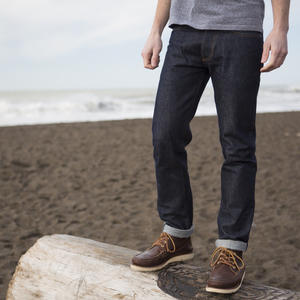What is selvedge denim? Just sound it out! It's not too far a leap from "selv-edge" to "self-edge", which means exactly what it sounds like. The term "selvedge" (sometimes spelled selvage) refers to the narrow, tightly woven band present on both edges of the famous fabric, which helps prevent unraveling and fraying.
Aside from being functionally more durable, the weaving process used to produce selvedge (more on that later) gives the fabric a cleaner and more polished appearance compared to conventional denim. The edge that gives it its name is often white with a colored yarn in the middle, with red yarn specifically being referred to as iconic "redline" selvedge. This makes for a striking detail which you can show off by cuffing the legs, and you'll definitely see more colors than just red used to ID different variations and fabric runs.
Selvedge denim is intrinsically more labor-intensive and expensive to produce, as it requires more time and attention to detail than is typically found in non-selvedge denim production. Manufacturers of selvedge typically also invest in better quality yarn and dye, resulting in a superior final product. Some mills take this to the extreme, and produce small batches of high quality denim that have been hand dyed in bundles of yarn called hanks, or skeins.
Selvedge jeans can be incorporated effortlessly into your existing wardrobe, and the satisfaction of owning and fading a quality pair can be quite addictive. The craftsmanship, composition, and care necessary to produce this type of denim ensures that it withstands intense daily use, making it an ideal choice for those seeking a long-lasting addition to their wardrobe.
Want to learn more about selvedge denim? Check out our blog post: What is selvedge denim?






















